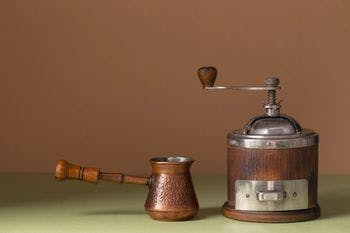
How to Adjust and Calibrate Your Coffee Grinder?

Have you ever found your coffee getting weak or bitter, even after the use of the best beans?
Don't worry! It happens to all of us. Now you must be wondering why. Well! It's because of not adjusting and calibrating your coffee grinder well.
So to cater to you and help you experience the best flavorful coffee, Today in this blog I will dive deeper into this topic.
Here I will share with you everything from what adjusting and calibrating your coffee grinder is to the things to take care of while doing so.
So let's step ahead.
What does it mean to adjust and calibrate a grinder?
Adjusting your grinder is like fine-tuning. It's about finding the perfect fit for your taste buds. The grind size, which refers to how finely or coarsely the coffee beans are ground, plays a major role here.
Different brewing methods demand different grind sizes – think of it as the major contributor to your perfect coffee.
For example, a French press prefers a coarse grind for that full-bodied richness, while an espresso machine works best by tuning on a fine grind, ensuring a concentrated and bold flavor.
Calibration on the other side takes the whole adjusting session to the next level, adding a touch of precision to your grind settings.
It involves ensuring that your grinder consistently delivers the ideal grind size you desire. Calibration eliminates inconsistencies, ensuring that each grind works well.
In simpler terms, adjusting is finding the right spot on the dial for your desired grind size, while calibrating is making sure your grinder hits that spot accurately every time.
Significance of adjusting and calibrating the coffee grinder
1) Precision in flavor extraction
Adjusting and calibrating your grinder is all about precision – the trick that enhances your coffee experience. Each brewing method, from French press to espresso, demands a specific grind size to extract its full flavor potential. Thus adjusting becomes prominent.
2) Tailored to your taste buds
No two coffee lovers are the same, and neither should their coffee be. Adjusting and calibrating your grinder aids you to tailor your coffee to your unique taste preferences. Whether you crave a bold, robust cup or a smoother, milder one, your grinder here becomes the personal barista for customization. It's the difference between a one-size-fits-all and a customized coffee crafted just for you.
3) Consistency is key
Ever had a fantastic cup one day and been disappointed the other? Inconsistency in grind size is the reason. Adjusting and calibrating your grinder ensures a consistent grind size, cup after cup, day after day. This consistency is the secret that turns your coffee routine into a ritual, offering a reliable and delightful experience every time you brew.
4) Preserves bean quality
Your premium coffee beans deserve royal care. Adjusting and calibrating your grinder means you're treating those beans in the right way. A precise grind size ensures that the beans' flavors are extracted optimally, preserving their quality and allowing you to savor the hidden flavors within.
In short, adjusting and calibrating your coffee grinder is the difference between a random coffee experience and a customized cup.
How to identify that your grinder needs calibration?
1) Inconsistent grind size
If you find your grinder giving different grinds between brews, just check the calibration. Inconsistency in grind size is a clear signal that your grinder might need some calibration.
2) Brewing time fluctuations
If your grinder's brew time keeps fluctuating for different brews, calibration can be the reason. It affects the extraction rate, leading to unpredictable brewing times.
3) Unusual noises or resistance
While grinding if your grinder makes odd noises or experiences increased resistance during operation. Then these unusual sounds or increased resistance may indicate misalignment, signaling the need for calibration.
4) Changes in taste
If your coffee doesn't taste as delightful as it used to, with unexpected flavor variations. Then it can be a result of inconsistent grind sizes affecting the extraction process.
5) Beans getting stuck
Do your coffee beans occasionally get stuck in the grinder? Again beans getting stuck is an indication of improper alignment, demanding calibration.
Tools needed
Common tools
1) Flat-head screwdriver
Many grinders include adjustment screws that need a flat-head screwdriver to turn.
2) Phillips-head screwdriver
Some grinders, especially electric models, might require Phillips head screws for adjustments.
3) Allen wrench
Less common, but some higher-end grinders might utilize Allen wrenches for specific adjustments.
4) Brush
A small, stiff brush is required for cleaning out leftover coffee grounds before and after making adjustments.
5) Scale (optional)
While not essential for basic calibration, a scale can be very useful in measuring precise grind sizes, especially for espresso or other methods requiring specific ratios.
Additional Tools (specific models)
1) Wrench
Certain manual grinders need a wrench to loosen or tighten burrs for adjustment.
2) Calibration key
Some grinders come with a dedicated key or tool for adjusting the grind size.
3) Manual
It's always best to read your grinder's manual for specific instructions and tools recommended by the manufacturer.
Steps to calibrate your coffee grinder
Step 1: Select your tools
Gather your tools, including a screwdriver set, wrench or pliers, digital scale, timer, reference chart, and a cleaning brush.
Step 2: Explore the Manual
Go through your grinder's manual for complete guidelines and to know the best manufacturer recommendations.
Step 3: Empty the grinder
Make sure the grinder hopper is empty and has no leftovers to prevent any coffee beans from affecting your adjustments.
Step 4: Check the burrs
Analyze the burrs for any coffee sediments. Use the cleaning brush to clear any lingering grounds.
Step 5: Begin with a coarse setting
Set your grinder to the coarsest setting. This will act as a foundation for adjustments.
Step 6: Try grinding a small batch
Grind a small batch of coffee beans and analyze the grind size. Note if there are any inconsistencies or irregularities.
Step 7: Make incremental adjustments
Gradually adjust the grind size again, making small increments between each adjustment. Refer to your reference chart for ideal settings for your preferred brewing method.
Step 8: Brew again and taste
Brew a sample coffee again at each new grind setting. Taste and analyze the flavors. Note down any improvements or significant changes.
Step 9: Dial in the grind size
Adjust until you achieve the desired grind size for your chosen brewing method.
Step 10: Calibrate for consistency
If your grinder has calibration features, follow the manufacturer's instructions for precise calibration. This step makes sure that your grinder consistently delivers the chosen grind size.
Step 11: Monitor brewing time
Make use of a timer to monitor the brewing time—consistent grind size results in a consistent extraction, leading to predictable brewing times.
Step 12: Fine-tune as needed
Fine-tune your adjustments based on taste preferences. Remember, it's a personal journey, and the perfect cup can be customized as per your liking.
Care to take while calibrating a coffee grinder
1) Begin with cleanliness
Before delving into calibration, ensure your grinder is spotless. Lingering residues from past grinds can affect the accuracy of adjustments. Use a cleaning brush to thoroughly remove any remaining grounds.
2) Thorough manual reading
Each grinder possesses its unique attributes, and manufacturers provide specific calibration guidelines. Review the manual completely to understand recommended procedures and any dedicated tools or features for calibration.
3) Adjust at different intervals
Calibration isn't a one-time job; it's a gradual journey. Make minor, step-by-step adjustments to prevent drastic shifts in grind size. This approach enables you to observe the impact of each adjustment and refine it as required.
4) Note flavor impact
Calibration is not just about reaching a specific grind size; it's about crafting a flavor profile. As you make adjustments, brew small samples and taste the results. Analyze how changes in grind size influence the flavor and aroma of your coffee.
5) Embrace patience
Rushing in calibration can lead to excessive adjustments and an imperfect grind size. Take the time to precisely dial in the perfect setting tailored to your preferred brewing method.
6) Record your journey
Maintain a comprehensive log of your calibration journey. Record grind settings, brewing times, and corresponding flavor profiles. This documentation becomes a valuable reference for future adjustments, ensuring consistency in your coffee-making ritual.
7) Regular calibration routine
Variables like humidity, temperature, and usage patterns can impact your grinder's performance. Regular calibration guarantees sustained precision over time.
8) Fine-tune according to taste
Calibration exceeds achieving a specific grind size; it's about tailoring a coffee cup that captivates your taste buds—Fine-tune adjustments to align with your distinctive preferences for strength, flavor, and aroma.
The final words
So, there you have it, coffee lovers! That's a wrap for this blog.
Remember, it's a journey, not a destination. Each tweak, each test brew is a step closer to mastering the grind and conquering the coffee goodness. For more such coffee adventures, don't forget to subscribe to our YouTube channel. Also, follow us on Instagram and learn more about coffee.
FAQs
1) How often should calibration be done?
Calibration should be done at regular intervals, ideally every few weeks, to maintain precision, especially with changes in humidity, temperature, and usage.
2) What if you keep using a coffee grinder without calibrating it?
Continuous use without calibration may result in inconsistent grind sizes, affecting the flavor and your coffee quality.
3) I regularly clean my coffee grinder. Will my grinder ever need calibration?
Regular cleaning is essential, but calibration is still necessary to ensure accurate grind size and optimal brewing results.

I am a barista by profession hailing from NC. My journey began in my late teens when I started working as a barista in a local coffee shop. My passion for coffee quickly became evident as I immersed myself in the art of espresso extraction, latte art ...



